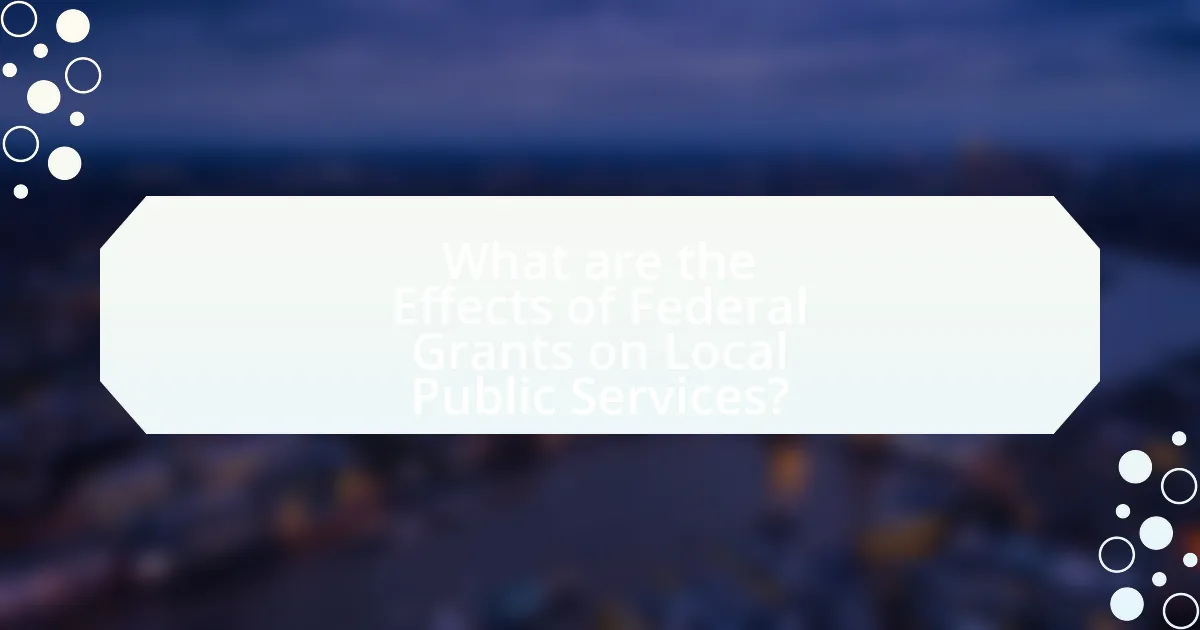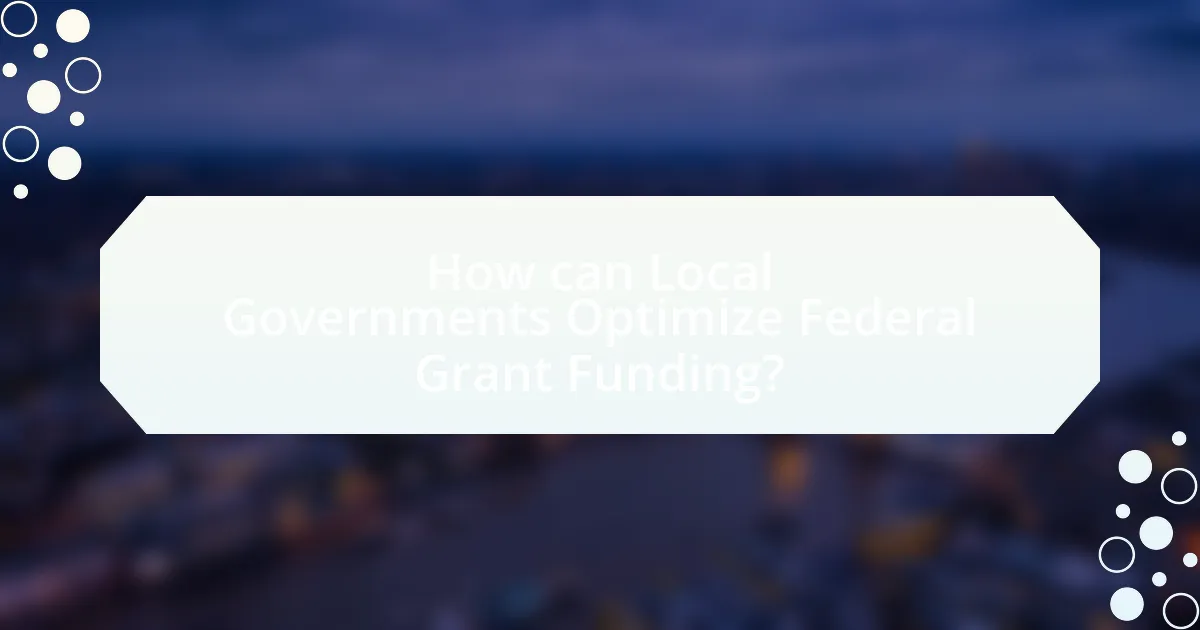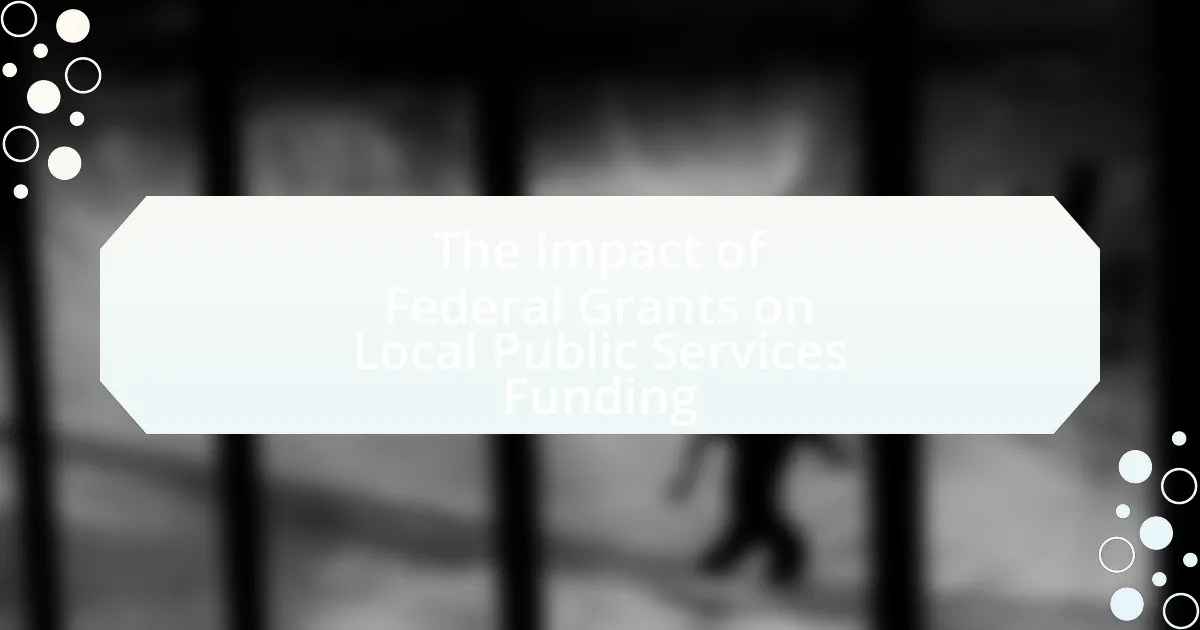Federal grants are financial awards from the federal government aimed at supporting public interest projects and programs, particularly in education, healthcare, infrastructure, and social services. The article examines the critical role these grants play in funding local public services, highlighting their impact on community welfare and service delivery. It discusses the types of federal grants available, the allocation process to local governments, and the importance of these funds in enhancing local services. Additionally, the article addresses the challenges local governments face in managing federal grants, the implications of dependency on such funding, and strategies for optimizing grant acquisition and management to improve public services.

What are Federal Grants and Their Purpose?
Federal grants are financial awards provided by the federal government to support specific projects or programs that serve the public interest. Their primary purpose is to fund initiatives in areas such as education, healthcare, infrastructure, and social services, thereby enhancing local public services. For instance, in the fiscal year 2021, the federal government allocated over $800 billion in grants to state and local governments, which underscores the significant role these funds play in supporting essential services and programs at the community level.
How do Federal Grants function in the context of local public services?
Federal grants function as a crucial funding mechanism for local public services by providing financial resources that support various community programs and initiatives. These grants are allocated by federal agencies to state and local governments, enabling them to enhance services such as education, healthcare, infrastructure, and public safety. For instance, the U.S. Department of Education distributes Title I funds to schools in low-income areas, which directly impacts educational services and resources available to students. Additionally, the Federal Emergency Management Agency (FEMA) provides grants for disaster relief, allowing local governments to improve emergency preparedness and response capabilities. This funding is essential for localities to address specific needs and improve overall community welfare, demonstrating the significant role federal grants play in sustaining and advancing local public services.
What types of Federal Grants are available for local public services?
Federal grants available for local public services include Community Development Block Grants (CDBG), Emergency Solutions Grants (ESG), and the Substance Abuse and Mental Health Services Administration (SAMHSA) grants. CDBG funds support a wide range of community development activities aimed at improving the economic and social well-being of low- and moderate-income individuals. ESG grants provide funding for services to prevent homelessness and assist those experiencing homelessness. SAMHSA grants focus on improving mental health and substance abuse services at the local level. These grants are essential for enhancing local public services and addressing community needs effectively.
How are Federal Grants allocated to local governments?
Federal grants are allocated to local governments through a structured process that involves federal agencies distributing funds based on specific criteria and needs. The allocation typically considers factors such as population size, poverty levels, and specific project requirements, ensuring that funds are directed to areas with the greatest need or potential impact. For instance, the U.S. Department of Housing and Urban Development allocates Community Development Block Grants based on a formula that includes the number of low- and moderate-income residents in a locality. This method ensures that federal resources are effectively utilized to support local public services and address community challenges.
Why are Federal Grants important for local public services funding?
Federal grants are crucial for local public services funding because they provide essential financial resources that enable municipalities to deliver vital services such as education, healthcare, and infrastructure. These grants often fill budget gaps that local governments face, especially in economically disadvantaged areas where tax revenues may be insufficient. For instance, in 2020, federal grants accounted for approximately 30% of total state and local government revenue, highlighting their significant role in supporting public services. By supplementing local budgets, federal grants help ensure that communities can maintain and improve essential services, ultimately enhancing the quality of life for residents.
What role do Federal Grants play in enhancing community services?
Federal grants significantly enhance community services by providing essential funding that supports various local initiatives. These grants enable communities to develop and improve services such as education, healthcare, infrastructure, and public safety. For instance, according to the National Association of Counties, federal grants accounted for approximately 30% of total funding for local public services in 2020, illustrating their critical role in sustaining and expanding community programs. By alleviating budget constraints, federal grants empower local governments to address pressing needs and implement innovative solutions that directly benefit residents.
How do Federal Grants impact the quality of local public services?
Federal grants significantly enhance the quality of local public services by providing essential funding that supports various programs and initiatives. These grants enable local governments to improve infrastructure, education, healthcare, and public safety services, which directly benefits community well-being. For instance, according to the National Association of Counties, federal grants accounted for approximately 30% of local government revenue in 2020, allowing for the expansion of critical services such as emergency response and public health initiatives. This financial support leads to improved service delivery, increased access to resources, and better overall outcomes for residents.

What are the Effects of Federal Grants on Local Public Services?
Federal grants significantly enhance local public services by providing essential funding that supports various programs and initiatives. These grants enable local governments to improve infrastructure, education, healthcare, and social services, which might otherwise lack adequate financial resources. For instance, according to the National Association of Counties, federal grants accounted for approximately 30% of local government revenue in 2020, illustrating their critical role in funding essential services. Additionally, studies show that federal funding can lead to improved service delivery outcomes, such as increased access to healthcare and enhanced educational resources, thereby positively impacting community well-being.
How do Federal Grants influence local government budgets?
Federal grants significantly influence local government budgets by providing essential funding that supports various public services and projects. These grants often cover specific areas such as education, infrastructure, healthcare, and public safety, allowing local governments to allocate their limited resources more effectively. For instance, according to the National Association of Counties, federal grants accounted for approximately 25% of total county revenues in 2020, demonstrating their critical role in financing local initiatives. This influx of federal funds enables local governments to enhance service delivery, invest in community development, and address pressing needs without solely relying on local tax revenues.
What are the short-term effects of Federal Grants on local funding?
Federal grants have immediate positive effects on local funding by providing essential financial resources that can enhance public services. These grants often lead to increased funding for local projects, such as infrastructure improvements, education programs, and public health initiatives. For instance, a study by the National Bureau of Economic Research found that federal grants can increase local government spending by approximately 20% in the short term, allowing municipalities to address urgent needs without raising local taxes. This influx of federal funds can also stimulate local economies by creating jobs and supporting local businesses, thereby amplifying the benefits of the initial grant.
What are the long-term implications of relying on Federal Grants?
Relying on Federal Grants can lead to long-term dependency, which may undermine local funding stability. This dependency often results in reduced local revenue generation efforts, as municipalities may prioritize grant acquisition over developing sustainable funding sources. For instance, a study by the National League of Cities found that cities heavily reliant on federal funding faced budget shortfalls when grants were reduced or eliminated, leading to cuts in essential services. Additionally, the volatility of federal funding can create uncertainty in long-term planning for local governments, impacting their ability to invest in infrastructure and community programs effectively.
What challenges do local governments face with Federal Grants?
Local governments face several challenges with Federal Grants, including complex application processes, stringent compliance requirements, and potential funding instability. The application process often involves extensive documentation and can be time-consuming, which may deter local governments from pursuing available grants. Compliance with federal regulations requires significant administrative capacity and expertise, leading to increased operational costs. Additionally, funding can be unpredictable, as federal budgets may change, impacting the continuity of programs reliant on these grants. According to the Government Accountability Office, many local governments report difficulties in managing the administrative burden associated with federal grants, which can strain limited resources.
How do compliance requirements affect local public services?
Compliance requirements significantly influence local public services by imposing standards and regulations that must be met to receive federal funding. These requirements often dictate how funds can be allocated, necessitating transparency, accountability, and adherence to specific performance metrics. For instance, local governments may need to implement new reporting systems or modify existing programs to comply with federal guidelines, which can strain resources and affect service delivery. Additionally, failure to meet compliance standards can result in financial penalties or loss of funding, further impacting the ability of local public services to operate effectively.
What are the risks of dependency on Federal Grants for funding?
Dependency on Federal Grants for funding poses several risks, including financial instability, reduced local control, and potential misalignment with community needs. Financial instability arises because federal grants can be unpredictable and subject to changes in government priorities or budget cuts, which can leave local services vulnerable. Reduced local control occurs as reliance on federal funding often requires adherence to federal guidelines and regulations, limiting the ability of local governments to tailor services to their specific community needs. Additionally, misalignment with community needs can happen when federal funding focuses on specific programs that may not address the most pressing issues faced by local populations, leading to inefficient use of resources. These risks highlight the challenges local governments face when overly reliant on federal grants for essential services.

How can Local Governments Optimize Federal Grant Funding?
Local governments can optimize federal grant funding by implementing strategic planning, enhancing collaboration, and improving grant management processes. Strategic planning involves identifying community needs and aligning them with available federal funding opportunities, ensuring that grant applications are targeted and relevant. Collaboration with local stakeholders, including non-profits and community organizations, can strengthen grant proposals by demonstrating community support and shared objectives. Additionally, improving grant management processes, such as tracking expenditures and outcomes, can enhance accountability and facilitate future funding opportunities. According to the National Association of Counties, effective grant management can lead to a 20% increase in successful funding applications, underscoring the importance of these strategies.
What strategies can local governments employ to secure Federal Grants?
Local governments can employ several strategies to secure Federal Grants, including thorough research on available grants, building strong partnerships, and developing comprehensive proposals. Researching grants involves identifying federal programs that align with local needs, as evidenced by the Catalog of Federal Domestic Assistance, which lists over 1,000 federal assistance programs. Building partnerships with local organizations and stakeholders enhances the credibility of grant applications, as collaboration often leads to more impactful projects. Additionally, developing comprehensive proposals that clearly outline project goals, budgets, and expected outcomes increases the likelihood of funding approval, supported by the fact that well-structured proposals are more likely to meet federal criteria and demonstrate community benefit.
How can local governments improve their grant application processes?
Local governments can improve their grant application processes by streamlining application procedures and enhancing accessibility for applicants. Simplifying forms and providing clear guidelines can reduce confusion and increase participation. For instance, the National Council of Nonprofits reports that complex applications often deter potential applicants, leading to underutilization of available funds. Additionally, offering training sessions and workshops can equip local organizations with the necessary skills to navigate the application process effectively. This approach has been shown to increase successful grant applications, as evidenced by the success of various local governments that implemented such initiatives, resulting in higher funding rates and improved public services.
What best practices should be followed for effective grant management?
Effective grant management requires clear communication, thorough documentation, and regular monitoring of progress. Clear communication ensures that all stakeholders understand the grant’s objectives and requirements, which is essential for alignment and accountability. Thorough documentation, including maintaining accurate records of expenditures and activities, supports compliance with grant conditions and facilitates audits. Regular monitoring of progress against established milestones allows for timely adjustments and ensures that the project stays on track. According to the Grant Management Association, organizations that implement these best practices are more likely to achieve their grant objectives and maintain positive relationships with funding agencies.
What resources are available for local governments seeking Federal Grants?
Local governments seeking Federal Grants can access several key resources, including Grants.gov, the Catalog of Federal Domestic Assistance (CFDA), and the Federal Register. Grants.gov serves as a centralized platform for finding and applying for federal funding opportunities, listing over 1,000 grant programs from various federal agencies. The CFDA provides a comprehensive directory of federal assistance programs, detailing eligibility requirements and application procedures. Additionally, the Federal Register publishes notices of funding opportunities, ensuring local governments stay informed about available grants. These resources collectively facilitate the identification and application process for federal funding, enhancing local public services.
How can local governments access grant writing assistance?
Local governments can access grant writing assistance through various resources such as state and federal agencies, nonprofit organizations, and professional grant writing services. State and federal agencies often provide technical assistance and training programs specifically designed to help local governments improve their grant writing skills. For example, the U.S. Department of Agriculture offers resources for rural development grants, while the National Endowment for the Arts provides guidance for arts-related funding. Nonprofit organizations, such as the Foundation Center, offer workshops and online courses focused on grant writing. Additionally, hiring professional grant writers or consultants can provide tailored assistance, increasing the likelihood of securing funding. These avenues collectively enhance the capacity of local governments to effectively pursue and obtain grants, thereby improving public services.
What online platforms provide information on available Federal Grants?
Grants.gov is the primary online platform that provides information on available Federal Grants. This website serves as a centralized location for federal grant opportunities, allowing users to search for grants by agency, category, or eligibility. Additionally, the Catalog of Federal Domestic Assistance (CFDA) offers detailed descriptions of federal programs, including grant opportunities, and can be accessed through the USA.gov website. Both platforms are essential resources for individuals and organizations seeking federal funding for various projects and services.
What are the best practices for utilizing Federal Grants effectively?
The best practices for utilizing Federal Grants effectively include thorough planning, compliance with regulations, and ongoing evaluation of outcomes. Thorough planning involves identifying specific needs and aligning grant objectives with local public service goals, ensuring that the funding addresses critical areas. Compliance with federal regulations is essential, as it helps avoid penalties and ensures that funds are used appropriately; for instance, adhering to the Uniform Guidance regulations can streamline the grant management process. Ongoing evaluation of outcomes allows organizations to assess the impact of the grant-funded initiatives, facilitating adjustments and improvements based on data-driven insights. These practices are supported by the U.S. Government Accountability Office, which emphasizes the importance of strategic planning and compliance in maximizing the effectiveness of federal funding.

Leave a Reply